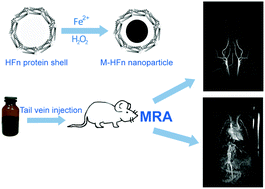Positive magnetic resonance angiography using ultrafine ferritin-based iron oxide nanoparticles†
Abstract
Iron oxide nanoparticles with good biocompatibility can serve as safe magnetic resonance imaging contrast agents. Herein, we report that ultrafine ferritin-based iron oxide (hematite/maghemite) nanoparticles synthesized by controlled biomimetic mineralization using genetically recombinant human H chain ferritin can be used as a positive contrast agent in magnetic resonance angiography. The synthesized magnetoferritin with an averaged core size of 2.2 ± 0.7 nm (hereafter named M-HFn-2.2) shows a r1 value of 0.86 mM−1 s−1 and a r2/r1 ratio of 25.1 at a 7 T magnetic field. Blood pool imaging on mice using the M-HFn-2.2 nanoparticles that were injected through a tail vein by single injection at a dose of 0.54 mM Fe per kg mouse body weight enabled detecting detailed vascular nets at 3 minutes post-injection; the MR signal intensity continuously enhanced up to 2 hours post-injection, which is much longer than that of the commercial magnevist (Gd-DTPA) contrast. Moreover, biodistribution examination indicates that organs such as liver, spleen and kidney safely cleared the injected nanoparticles within one day after the injection, demonstrating no risk of iron overload in test mice. Therefore, this study sheds light on developing high-performance gadolinium free positive magnetic resonance contrast agents for biomedical applications.

- This article is part of the themed collection: Research selection from the NCNST


 Please wait while we load your content...
Please wait while we load your content...